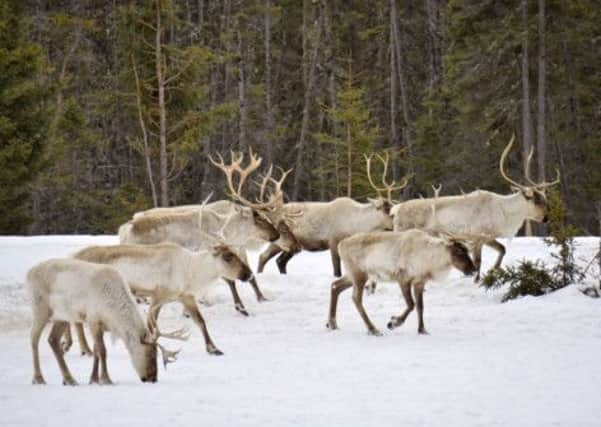Singing praises of natural world


Shimmering tinsel, a crimson-coated Santa Claus and mounds of mouth-watering mince pies; Christmas is certainly a bright and bold festival. What sets it apart from our other bright and bold festivals though, is the unavoidable presence of the natural world.
The wilderness seems to creep in at the very edges of the idea of Christmas, and, over the years, we have dragged into our homes spiky off-cuts of holly, sprigs of mistletoe and millions upon millions of Norway Spruce.
Advertisement
Hide AdAdvertisement
Hide AdOur Christmas cards are chock full of images of cheery Robins perched on frost-dusted shovels and of reindeer posing moodily amidst the snowfall.
One of the season’s best-loved carols – The 12 Days of Christmas – is focused around birds, in particular a partridge that for some reason or other has found itself stuck up a pear tree.
Why this imagery of the natural world still hangs heavy over a Christian festival probably harks back to our not-so-distant pagan past, when the winter solstice was umbilically linked to the wild world in which we lived.
As such, our modern Christmas just wouldn’t be Christmas without these 12 wild stars of Christmas.
1. Norway Spruce.
Advertisement
Hide AdAdvertisement
Hide AdYou have to blame the Germans for the all-conquering popularity of the Christmas Tree.
It’s all Prince Albert’s fault. Introduced by Queen Victoria’s husband to Windsor Castle 1841, the Norway Spruce quickly became the must-have emblem of Christmas. An estimated 8 million trees are shifted over the festive season annually in the UK alone.
2. Mistletoe.
With its ancient association with fertility and seasonal snogging, this evergreen shrub seems the most unlikely of plants to be linked with a Christian festival and its bawdy pagan associations meant the plant was actually banned from many church decorations well into the 1960s.
Hanging in unearthly green baubles amidst the colourless, seemingly lifeless winter landscape it’s easy to see why Mistletoe was believed to possess otherworldly, magical qualities.
3. Robin.
Advertisement
Hide AdAdvertisement
Hide AdDespite its image as the cheerful friend of the gardener, the Robin is actually a tempestuous, sex-obsessed brawler.
Highly territorial, the Robin, or ‘Ruddock’ as the bird was known, will pursue and fight an intruder to the death if necessary. It’s the Post Office’s fault that we link Robins with Christmas cards.
Victorian posties wore bright red uniforms and thus gained the nickname “robin redbreasts”. Over time, the association grew to such an extent that Robins and Christmas cards now go together like turkey and stuffing.
4 and 5. Holly and Ivy.
The Celts hung garlands of Holly outside their homes in the belief that the sprigs would protect them from evil spirits, although it is still considered bad luck to bring Holly indoors before Christmas Eve. Ivy, along with Holly, has been the mainstay of English Christmas decoration for church use since the 15th and 16th centuries. Ivy is a key source of nectar through the chilly days of autumn and early winter, and big Ivy bushes provide much-needed winter roosting sites for garden birds.
6. Reindeer.
Advertisement
Hide AdAdvertisement
Hide AdIt was the 1823 poem A Visit From St Nicholas by America professor Clement C Moore that began the association between Reindeer and Christmas. Although associated with the freezing northern wastes of Europe and America, a non-native herd roams the Cairngorms.
7. Turkey.
After the domestic chicken, the Turkey shares the dubious honour of being our most commonly devoured bird. Roaming wild and free across much of North America, Turkeys unlucky enough to be found in the UK are destined to be trussed-up, covered in bacon and shoved in the oven.
As ever, it was the Victorians who began the association between Turkeys and Christmas, with the bird replacing goose as the must-eat accompaniment to the December 25 feast.
8. Calling birds.
The line ‘four calling birds’ from The 12 Days of Christmas is believed to have originally read ‘four Colly birds’. Colly, an old word for black, in this context becomes Blackbird, which not so long ago was a key ingredient in any self-respecting cook’s pie.
Advertisement
Hide AdAdvertisement
Hide AdNowadays, rather than filling pies, Blackbirds are commonly seen mooching below bird tables, hoovering up scraps.
9. Turtle Dove.
Another character from The 12 Days of Christmas, the once common Turtle Dove has suffered a catastrophic population collapse and is now sadly the species most likely to become extinct in the UK.
10. Pheasant.
In some interpretations of The 12 Days of Christmas the verse ‘five golden rings’ actually refers to the ring-necked pheasant aka the Common Pheasant.
Pheasants strutting through the snow are now staple images for millions of Christmas cards.
11. Mistletoe Marble Moth.
Advertisement
Hide AdAdvertisement
Hide AdSomething of a Christmas wildcard, this tiny moth, looking undeniably like a bird dropping, lurks as a caterpillar in tiny burrowed mines inside Mistletoe leaves – perhaps something to remember when puckering up for that Christmas kiss.
12. A Partridge in a pear tree.
Last but not least, the Grey Partridge has been a traditional game bird in England for centuries, but its days as a festive dish could be numbered – the partridge, like its song-neighbour the Turtle Dove, is currently suffering from an alarming population decline.